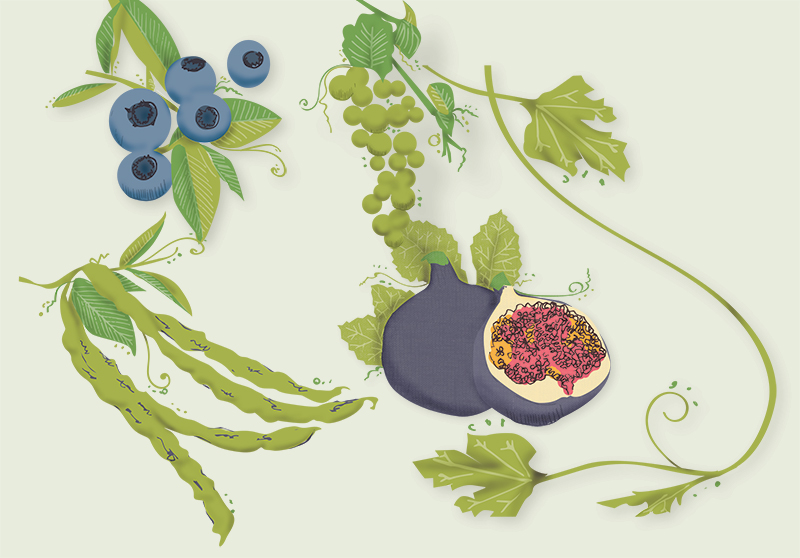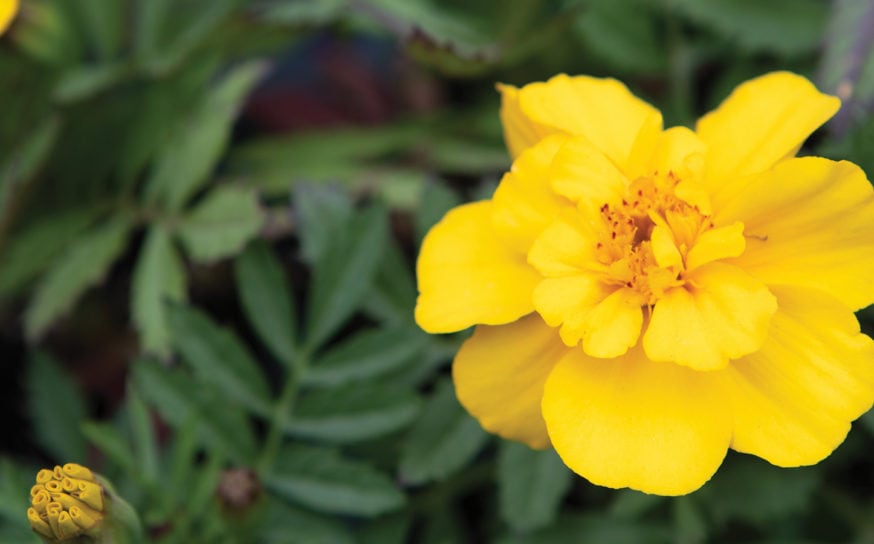
The Edible Garden
There was a time when Southern California gardens got by on good looks alone. A lush backyard oasis brimming with glossy, tropical ferns and flowering hibiscus lured us in. A […]
-
CategoryPeople
-
Written byChristy Hobart
There was a time when Southern California gardens got by on good looks alone. A lush backyard oasis brimming with glossy, tropical ferns and flowering hibiscus lured us in. A perfectly tended rose garden filled with prized varieties was a source of envy. An expanse of deep green lawn was a must. But now, with water becoming more and more precious (and expensive), these kinds of gardens just don’t make sense. It’s time to rethink our backyards.
Why not incorporate plants into your landscape that earn their keep, that give back something in return for the nutrients and water—and love and attention—we give them? A rose is a lovely gift, but apricots plucked from a shade tree are even better. A bay laurel hedge is just as efficient at defining a space as a common ficus—plus it smells divine and keeps you from making a last-minute run to the market. A pot of geraniums, however vibrant, comes up short when compared with the colorful—and edible—stalks of Swiss chard.
Landscape designer Miriam Rainville, often in collaboration with urban farmer Andy Vaughan, has been replacing “passive” plantings with “active” gardens for years, both in common spaces within affordable housing developments and on large, individual properties.
“Gardens can be ornamental as well as functional,” she says. “When you walk next to a row of fruit trees this time of year, they’re absolutely beautiful. The citrus is fleshing out, and the leaves are all shiny green. The smell of an orange tree in full bloom, with all the white flowers, is one of the greatest olfactory experiences ever.
Plus you can pick a dozen oranges from it and have fresh juice for breakfast.”
A garden filled with edibles does require some advance planning, however. “All soils are not created equally,” Miriam notes.
Valley soil tends to have too much clay or be too compacted. Adding amendments like compost, peat moss and worm castings will loosen the soil while adding enriching microorganisms. Amendments can also help soil hold the water so it is released slowly into the ground.
Before planting fruits and vegetables, do mix a healthy amount of rich, organic mulch into your soil. Miriam likes the Black Gold brand, available on Amazon.
Vegetables in pots can thrive with attentive hand-watering, but if you’re planning on something more extensive, consider installing drip irrigation lines—a smart choice for water conservation because they bring water right to the roots rather than sprinkling it down on the plant’s leaves. They can be moved to accommodate changing plantings, and some come with adjustable heads that release just the right amount of water to individual plants.
Once you have the prep work done, the fun begins. Here are Miriam’s top ideas for bringing edibles into a garden.
RAISED BEDS AND POTS
“There are many varieties of vegetables that look just plain cool,” Miriam says. She uses some—like the Lolla Rosa red lettuce and the Buttercrunch green lettuce—as borders. “The red and green looks amazing in mass—and you can eat them!” Others brighten up vegetable beds and pots.
Some of Miriam’s favorites for their exquisite flavors and good looks:
Banana peppers
Elongated, 6-inch peppers turn scarlet when fully ripe but stay sweet and mild. Expect amazing yields along our coast.
Black Zebra tomato
This heirloom-cross between a black tomato and Green Zebra produces deep purple fruit with green streaks. You’ll be tempted to leave this beauty on the plant, but pluck it. The rich, almost smoky flavor is delightful.
Fairy Tale eggplant
Tender, plump and sweet, these luscious-looking mini-marvels are little jewels of delicious, creamy flavor.
Garden Peach tomato
This unique heirloom looks like a small peach, complete with slightly fuzzy skin.
HEDGES
Surround your property or delineate a part of the garden with an edible hedge.
Blueberries
Miriam uses several varieties for hedging:
Sharpblue Southern Highbush Blueberry is a favorite for its intensely flavored, dime-sized, dark blue fruit. The plant is nearly evergreen in mild winter climates and bears fruit most of the year. It’s a vigorous plant that can grow to 6 feet tall.
O’Neal Southern Highbush Blueberry produces large, especially sweet fruit and grows to 5 or 6 feet tall. It’s self-fruitful, but plant it with another variety for largest crops.
One of the more unusual blueberries to come to the market here is Pink Lemonade Northern Highbush Blueberry. Translucent, white berries mature to a luscious, bright pink. They’re wonderfully sweet and have a firm texture. Cooks will want to plant them for the unexpected color and flavor they bring to a dish, while gardeners will include them for their beauty alone.
Pineapple guava
The dense, grey-green leaves of the pineapple guava, or Fejoia sellowiana, make a dense screen that’s punctuated with spectacular flowers and tasty fruit. Plant several seedlings in a row to make an attractive, evergreen hedge. Guava jam is a known treat, but pineapple guavas are just as tasty right off the tree. Slice in half and scoop out the sweet center with a spoon. The spring petals are a nice addition to mild salads and desserts.
Kumquat
The Nagami dwarf kumquat, which grows up to 8 feet high, is a lively hedge choice because of its dense foliage and pops of orange fruit. Kumquats, which originated in China, have an edible sweet rind and tart flesh, making them a favorite for marmalades and crystallizing. Their sweet yet tangy flavor lends itself to many dishes, from main courses to desserts.
ESPALIERED TREES
Espaliered trees will cover a wall or provide a living fence in the garden. Plant one that provides fruit, and you’ll be able to pluck off something delicious too. Keep in mind that these trees are deciduous, so in the winter months they’ll shed all their leaves—revealing their branch structures.
Apples
Three apple varieties tend to do well here: the Anna, the Dorsett Golden and the Early Dawn—producing sweet and crisp fruit, perfect for snacking or cooking. Although the Anna will produce fruit when planted alone, Miriam suggests planting it with a companion apple tree for cross-pollination and greater yield. Plant all three varieties for a show of beautiful pink and white blossoms starting early in the year and a profuse harvest from June through early October.
Figs
There are two great fig varieties for espaliering along the coast: the White Genoa with large, green-yellow skin and reddish pulp and the White Adriatic that has medium fruit with yellow-green skin and reddish pulp. Pluck when perfectly ripe for unrivaled sweetness.
Pears
Try the Baldwin variety, which has light green skin and a buttery flesh with a mellow pear flavor. The Flordahome, which produces attractive, yellow-green fruit with juicy, sweet flesh, is another good option. Other pears that do well without a frost are Fan-Stil and Hood. For proper pollination, different varieties of pear trees must be planted together. Try the Baldwin with the Fanstil and the Flordahome with the Hood. Or try all four.
Kaffir Lime
The Kaffir lime tree, a more unusual—but gorgeous—choice for an espaliered fence, is known for its aromatic leaves and the rind of its rough, green fruit (it produces little juice), used to flavor many Asian dishes. When deciding where to plant, keep in mind that the branches are thorny.
Grapes
Many ancient European grapes, such as Muscat of Alexandria, Ladyfinger types and Thompson Seedless, have made their way to the United States and grow particularly well in our climate. Also worth considering are some outstanding new varieties like Flame Seedless and Perlette.
LETTUCES AND OTHER VEGGIES
Get creative and adventurous with lettuces. Colors can range from light green to speckled red to bronze to almost black. Leaves can be frilly, floppy, upright or jagged. The taste of homegrown lettuce will have you swearing off bagged mixes for good.
Purple bell peppers
These sweet peppers start out green and turn purple, and then red. These are great for salads or for stuffing.
Purple Ruffles basil
Some green leaves will pop up among the frilly, 3-inch purple leaves.
Rainbow chard
As the name suggests, the plant is colorful. Tender leaves with brilliantly colored ribs.
Rattlesnake beans
The light-purple flowers of this prolific heirloom go on to produce speckled, green-and-purple streaked pods. The tasty beans inside—to be eaten fresh or dried—are speckled brown and tan.
Round zucchini
Fruit from the various varieties of these compact and prolific plants range from almost white to a speckled light green to dark green.
Turmeric
The flowers of the turmeric plant, known for health properties, are stunning and bring a lush, tropical aesthetic to gardens.
Architect May Sung Comes to The Rescue on a Studio City Reno Gone Wild
In the right hands…finally!











